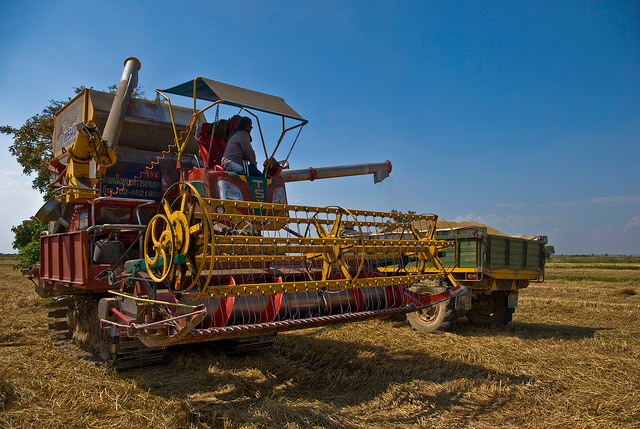
As we drove farther along the dry and dusty roads of the province, a combine harvester suddenly appeared on the horizon. It cut through the rice stalks almost as effortlessly as mowing a backyard lawn with an operator sitting on top of a lawn mower. This is a stark contrast to the traditional backbreaking and tedious harvesting process, in which farmers bend to gather and slash stalks using razor-sharp sickles. Some collect and tie the stalks while others thresh, by hitting the rice plant on a piece of wood. Then the farmers winnow the paddy and let the trash blow away from it. Farmers’ chats to let their minds drift away from the scorching sun and the harrowing labor have been replaced by the whirring sound of the machine making its way through the rice fields.
The combine harvester, an iconic image of farming in progressive countries, is becoming the usual scene in Cambodia—a hint that labor shortage during harvest time is becoming a serious problem for Cambodian farmers.
A dynamo of change
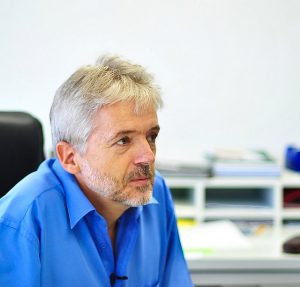
When Martin Gummert, an agricultural engineer at the International Rice Research Institute (IRRI), visited Cambodia for the first time in 2001, it reminded him of Vietnam in the 1990s, when the mechanization of the country’s agriculture was in its infancy. Its postharvest technology was at a very low stage. The milling industry was mismatched and outdated, and there was limited storage capacity. “Though there was a lot of poverty, I could sense the excitement of people trying to leave the past behind, grab every opportunity, move on, and develop,” recalled Engr.Gummert.
Many years back, in 1988, Harry Nesbitt and Glenn Denning, two of IRRI’s agricultural scientists, went to Cambodia to rebuild its rice production and “to breathe life back into the killing fields,” as the country was ravaged by the Khmer Rouge under Pol Pot. (See Towering legacies.)
Since almost all traditional knowledge on rice farming had been lost, Drs. Nesbitt and Denning were there to basically build a whole new farming infrastructure and a system of agricultural research for Cambodians to carry on. In 2001, a newly established Cambodian Agricultural Research and Development Institute then took over—part of the social context of the dynamism, which Engr. Gummert observed.
Wind of inspiration
Cambodia’s dynamic race to development specifically in rice production can be attributed to the tenacity of the Cambodians themselves. Their horrid history during the Khmer Rouge, 30 years back, seems to have faded in the background as they moved forward. Pyseth Meas, a postharvest expert on rice, is one of the members of the new generation unfettered by the nation’s challenging history. Instead, his past has become his inspiration. He vividly remembers growing up on a rice farm with his father, who was a government official before Pol Pot’s regime. When he lost his father during the war, his mother raised him and his siblings by selling rice. He witnessed his mother’s hard work and difficulty selling milled rice to consumers and traders. Like an imprint on his young mind, he was drawn to a profession that would ease the plight of those who depended on rice, such as his mother. Thus, he pursued a career in postharvest technology.
Pyseth Meas, a postharvest expert on rice, is one of the members of the new generation unfettered by the nation’s challenging history. Instead, his past has become his inspiration. He vividly remembers growing up on a rice farm with his father, who was a government official before Pol Pot’s regime. When he lost his father during the war, his mother raised him and his siblings by selling rice. He witnessed his mother’s hard work and difficulty selling milled rice to consumers and traders. Like an imprint on his young mind, he was drawn to a profession that would ease the plight of those who depended on rice, such as his mother. Thus, he pursued a career in postharvest technology.
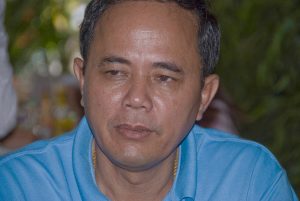
“I could see that this was where I could contribute more to my country—knowing that 85% of the Cambodian farmers are rice farmers,” Dr. Meas said. “All of my life, I’ve wanted to do something for the Cambodian people, especially the farmers, because we rely on rice as our staple food and main source of income. So, when I became involved in a project on postharvest as a partner with IRRI, I was more than happy.”
In 2005, the Post production Work Group (PPWG) under IRRI’s Irrigated Rice Research Consortium, funded by the Swiss Agency for Development and Cooperation, pooled its resources together with the Asian Development Bank (ADB) and the Japan Fund for Poverty Reduction (JFPR) to fund the project Improving Poor Farmers’ Livelihoods through Improved Rice Postharvest Technology. It was designed and initially led by Joseph Rickman, who was then the head of the Agricultural Engineering Unit at IRRI. When he moved to Africa in 2006, Engr. Gummert took the lead.
The project’s goal was to demonstrate to some villages in Battambang and Prey Veng provinces that improved harvesting, drying, storage, and milling can help farmers increase incomes from rice harvests and improve the quality of grain and seeds throughout the postharvest chain.
In February 2006, farmers’ and rice millers’ needs were assessed through a survey. Hearing from the farmers themselves, the project team was able to determine that the farmers needed dryers, especially during the rainy season, when paddy quality was at a high risk of deteriorating quickly, and combine harvesters to solve the labor shortage.
The first line of defense
Since knowledge is the first line of defense in this case—against postharvest losses—the project team conducted a trainers’ training in the same year to share their knowledge and expertise on improved postharvest options among the staff of the provincial agricultural extension services and their project counterpart in Cambodia. In the second half of 2006 and 2007, knowledge and skills in postharvest technologies smoothly cascaded to the farmers, as these trainers visited a total of eight villages. They taught and advised farmers regarding grain and seed quality, and safe storage options such as harvesting, threshing, cleaning, drying, hermetic storage, and milling.
Labor shortage
Just like in other countries, the young generations in rural farming areas move to the cities to find better jobs. With fewer hands, it is almost next to impossible to hold together the work on the farm. “Cultivating a hectare of land,” according to Dr. Meas, “needs about 100–120 person-days. And, about 40% is spent on establishing the crop and another 40–45% for harvesting.”
Small machine, huge effect
Then came the mini-combine harvester, also known as a mini-combine or simply combine. It fuses four operations (reaping, collecting, threshing, and cleaning) in one machine.
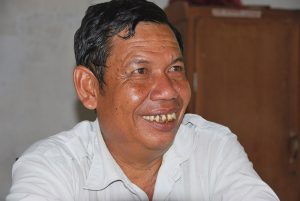
When the team brought in this small contraption from Vietnam, they had two reasons in mind: one, to reduce the high harvesting cost caused by a lack of labor and, two, to increase the quality of the grain.
After they showed how a minicombine works to farmers in both Battambang and Prey Veng provinces, combines in different sizes have become a big hit.
Net Kimyorn of Boeng Pring Village in Battambang said, “My fields are already less prone to accidents like fire.”
In Cambodia, it was common for soon-to-be-harvested rice to catch fire, caused by lit cigarette butts thrown in the rice fields. Since harvest time falls during the summer season, rice fields are vulnerable to fires. Mr. Kimyorn recalled a fire in his community in 1993 when 98 hectares of rice fields were turned into ashes because a drunken man cooked rice near the fields. Lucky for Mr. Kimyorn, his rice fields were spared.
“Moreover, we can harvest the crop on time, with less labor, and at less cost,” Mr. Kimyorn said. “And, we do not rely on the climate anymore. Before, it took almost a month to harvest a crop. Now, it takes only a few days. Less likely for rain to come while we are harvesting.”
To manually harvest a hectare of rice field, a farmer needs to hire at least 25 persons. The farmer pays each one US$3–4 per day or spends $100–120 per hectare. Aside from it taking longer, the workers would still need to gather the crop for threshing.
Hiring a combine harvester with an operator, on the other hand, costs $90–100. Aside from the difference in cost, grain quality is better, and it doesn’t take so much time. A large combine harvester with a cutting width of 3 meters, for example, can harvest a hectare in only an hour.
Now, with less labor required in the field, Mr. Kimyorn and his family can devote their extra time to other income generating activities such as fishing and selling noodles. Most of all, the family can spend more quality time with each other.
Competition benefits the farmers
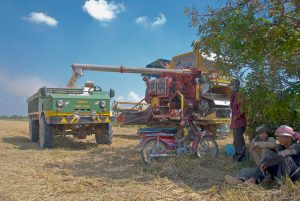 There are even some cases wherein farmers do not need to do much after harvesting because, recently, buyers from Vietnam and Thailand have been purchasing rice directly from them.
There are even some cases wherein farmers do not need to do much after harvesting because, recently, buyers from Vietnam and Thailand have been purchasing rice directly from them.
According to Dr. Meas, though these purchases are informal and are not in good order, farmers benefit much from them. Without buyers crossing the border, farmers rely mostly on rice millers to buy their paddy. However, with competition, farmers can ask for a better
price.
This does not mean, however, that drying is no longer needed. Some farmers dry and store their rice, then wait until the price is high before they sell it. This is when the information board greatly helps farmers. The use of information boards, as part of the holistic package of the PPWG of IRRI, gives up-to-date reports on the rice prices in the market, allowing farmers to plan the best time to sell their rice.
In addition, most farmers set aside an amount of rice for their family’s food until the next harvest and sell only the surplus. Thus, they still need the benefits from the mechanical drying technology.
Flatbed dryers
Bringing technology to farmers is important for them to see their options up close. Thus, in 2007, the team introduced mechanical drying in Cambodia, by installing the first flatbed dryer in Ballat Village, Battambang, in collaboration with the irrigators’ association. When the farmers from the Po Chrey community in Prey Veng heard about the benefits of using mechanical dryers, they requested the project team to help them install a mechanical dryer in their village. The team assisted the community by providing a blower and rice husk furnace, while the farmers financed and installed the drying bin and the shed.
In early 2008, two dryers were installed in Po Chrey community: one was initially supported by the PPWG and the other was set up by the private company ABK in cooperation with the community. Dryers became so in demand that, by mid-2009, the number of dryers increased to nine. Now, the country already has 11 known dryers.
Before, Koul Savoeun, just like other farmers in Ballat Mancheay Village of Battambang Province, had no idea about moisture content. He relies only on his gut feeling in determining whether the paddy is dry or not. After learning about moisture content, he noticed that his grains became clean, had no bugs, and had better quality According to Mr. Savoeun, after milling, sun-dried rice is yellowish and has more broken grains than rice dried using the mechanical dryer. Since the quality of the grains dried through a mechanical dryer has improved, the price has stepped up also, from $23 per bag to $25 per bag (a bag contains 50 kilograms of rice).
Mr. Savoeun added that they no longer depend on the climate to dry their paddy. They can dry their paddy even during rainy days.
Storing the harvest
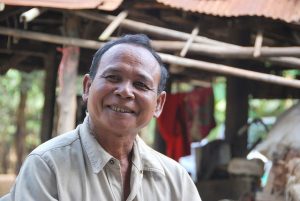
Even if grains are properly dried, this does not mean that farmers are free from potential postharvest losses. “In storage, losses to insects, rodents, and birds are estimated to be 5–10%,” according to Engr. Gummert.
Rice stored in homes is as common as a spirit house standing in each front yard in Cambodia because a Khmer family secures its rice consumption until the next harvest. Others store grains to sell when the price is at its peak.
Seum Kouy, a farmer in Prey Stor Village, Prey Veng, said that with the improved granary—a technology also promoted by the project—her grains are protected from rain, insects, birds, and rats.
And, for grains stored as seeds, IRRI provides the hermetic “Super Bag,” which protects the germination ability of the seed (see Fighting Asia’s postharvest problems).
Plausible promise
ADB has been funding a new project, Bringing about a Sustainable Agronomic Revolution in Rice Production in Asia by Reducing Preventable Pre– and Postharvest Losses, since 2009. It builds on the pilot activities of the ADB-JFPR funded project, which ended in 2008,and aims to reduce postharvest losses by scaling out technologies that have been proven effective. With the success of postharvest technologies in Cambodia, how did the team know that the technologies were mature enough to be released? “I think a technology is never mature enough to be released,” explained Engr. Gummert. “It’s always a process; you have to start with something. We call it a plausible promise, wherein the technology has the potential to solve a problem.”
Vietnam has commercially produced 6,000 mechanical dryers, being used in counties in the Mekong Delta. For the team, this is a hint that the technology is sound and could also be applicable in Cambodia. Hence, “it became a starting point to introduce the technology in another country, rather than initiating a research project to design a new dryer,” Engr. Gummert explained.
The combine was first introduced as mini or small. Its cutting edge of about 1 meter was just suited for small blocks of rice fields. “The reason was that it was cheap and affordable,” said Engr.Gummert. “We knew that it was limited in terms of capacity and it is not the technology that can treat all the needs of farmers.”
Now, farmers adapt the technology to their needs. Since Cambodia has bigger rice areas, medium (2-meter cutting width) and large combine harvesters (3-meter cutting width) have been imported from Thailand, Vietnam, and China.
Developing Cambodia’s potential
United States Department of Agriculture report in 2009 says that Cambodia aims to double its rice production in 2015 and become a major exporter. According to Dr. Meas, the country already has a surplus for export even if its average rice production is only 2.7 tons per hectare and it has poor irrigation infrastructure (only 15% of its rice areas are irrigated). Thus, it has more potential to go up. “As far as I know, Thailand is already near its ceiling; I don’t think it has more space to climb up,” Dr. Meas added.
“If the country will use modern varieties along with improved irrigation infrastructure, let alone use postharvest technologies, the country may even triple its present rice production,” Dr. Meas confidently predicted.
Contribution to the country’s goal
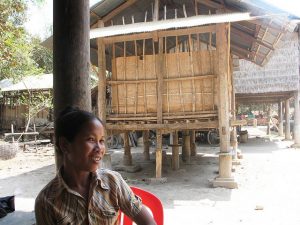 It is hoped that postharvest technologies will help Cambodia attain its goals to be a major exporter and double its production in 2015. For Engr. Gummert, there are two ways in which better postharvest management can contribute to the country’s goal. First, Southeast Asia loses 15–25% of grains because of spoilage and pests. Reducing these losses will contribute to the country’s rice output. The other area is basically quality. “Better quality directly affects the ability to export rice because, to become a major exporter,” explained Engr. Gummert, “the country needs to produce quality consistently. And, only by using advanced postharvest technology can this be attained.”
It is hoped that postharvest technologies will help Cambodia attain its goals to be a major exporter and double its production in 2015. For Engr. Gummert, there are two ways in which better postharvest management can contribute to the country’s goal. First, Southeast Asia loses 15–25% of grains because of spoilage and pests. Reducing these losses will contribute to the country’s rice output. The other area is basically quality. “Better quality directly affects the ability to export rice because, to become a major exporter,” explained Engr. Gummert, “the country needs to produce quality consistently. And, only by using advanced postharvest technology can this be attained.”
Cambodia cannot definitely rely on manual labor if it wants to be a major exporter some day. Dr. Meas explained that if a country, let us say the Philippines, wants rice from Cambodia, it prefers only one or two varieties. The same variety ripens at the same time. If manual labor is used to harvest, it is difficult to maintain the grain quality; and, because of labor shortages, it is impossible to harvest this variety at the same time. Some plants will be less mature, and others overripe.
“If the rice is less mature, it will have less milling output; if it is overripe, it will have a lot of breakage,” Dr. Meas explained. “Therefore, use of machinery is imperative for Cambodia to become an exporter.”
No doubt, combine harvesters and flatbed dryers, among other postharvest technologies, are radically transforming how farmers farm in Cambodia. It goes without saying that Cambodia is moving toward efficiency and modernity as it strives to increase rice production and leapfrogs to become a major rice exporter in Asia.
Ms. Reyes is the managing editor of Rice Today . Ms. Mendoza is a senior communication specialist at the International Rice Research Institute.






